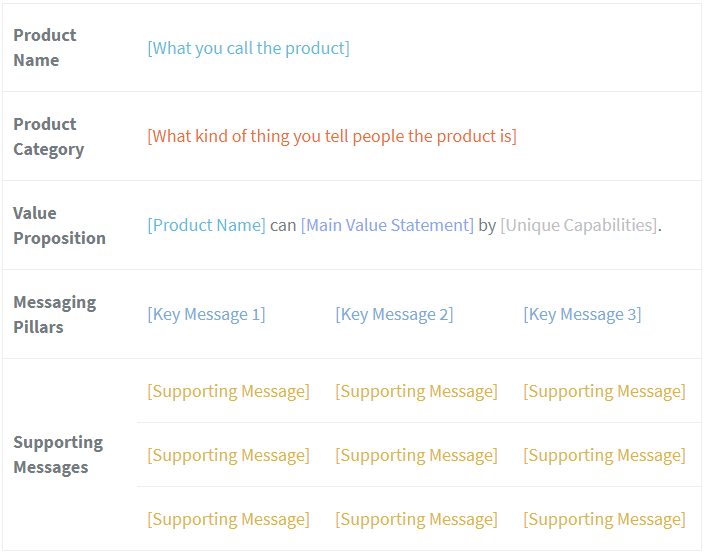
Use Message Maps to Deliver Higher Conversion Rates and Better Customer Experiences
Jonathan Bracken
- Make the messaging and positioning easier to manage by driving structure into the messages being used across marketing and the rest of organization
- Drive more consistent application of messages across the content and teams that use it
- Facilitate the review process with product teams and executives with a centralized location for messaging and positioning
The Benefits of Message Maps
1. Message Consistency
While many may intuitively agree that it’s a good idea to be consistent (just like daily hygiene routines) they also might not fully appreciate just how important having consistent messaging actually is. By delivering clear and consistent messages throughout your content and from all your prospect (and customer) facing people, your company will significantly increase conversion rates while improving efficiency. Brad Smith from Codeless said on the Moz blog he was able to increase their customer’s conversion rate by >200% through improved alignment between the messages on the landing pages and the messages in the google ads. In Conversion Optimization, experts like Oli Gardner at Unbounce call this “Message Match”. And the same logic can be applied throughout the buyers’ journey where you can increase conversion rates by consistently reinforcing the messages in each subsequent step along the way. Not only is a consistent messaging approach more effective, but it’s more efficient (less costly) too. Whether you agree with Ebbinghaus or Thomas Smith or whomever, psychology experts are consistent in inferring that message repetition to a potential buyer is required in order to help them:- Notice your existence and
- Develop willingness to take action
2. Messaging Quality
By having a structured, centralized approach to message dissemination across the team, you reduce the chances of people “taking matters into their own hands” and creating their own messaging. You also eliminate the situations where some people are still using messages from an older version of your product. Instead, with a message map you can create the single location where people can go to get the authentic messages that you’ve painstakingly created with your team.3. Time-Savings
By creating and approving your messages once and then applying them consistently across all the relevant assets and communications, you eliminate redundant review and edit cycles. Without a message map, companies often go through some sort of review process for the messaging on every new or updated asset.The Value and Limitations of Simple Messaging Frameworks
If you’re just getting started you might want to begin with a simple messaging structure that can be formative for what will come later. While simple messaging frameworks are great for defining initial, high-level messaging they are too limited in what they can do for you over time. Typically they include at least the high-level value proposition for the product, maybe three messaging pillars and a few supporting messages. Here’s an example:
It can be helpful with your elevator pitch or for talking points at a tradeshow, but it doesn’t have the depth to assist in driving consistent messaging across most marketing and sales assets or conversations as they get deeper.
Datasheets, web pages, product blog post and sales pitches will need more details, so if all you have is the high-level framework, you (or someone else in your company) will end up needing to create more messaging to fill in the gaps on each piece of content. And that’s when quality and inconsistency of messaging can become a real problem.
Detailed Message Maps
Main Components
First, you’ll need to go through a detailed message mapping exercise.
You can start with what you have in your high-level messaging framework, then drill down until you have the desired level of detail.
Here are some key elements to include in your message map:
- All of your products
- Features for your products and what those features do
- How they benefit individual personas
- How they work together to create value for your customers
- How they contribute to solutions and use cases
Customizing Your Message Map Template
Customize the exact dimensions based upon the complexity of the product and complexity of the selling situation.
For example, if you want to separate the benefit from the feature description, you should add a benefit dimension to your message map. But remember that you don’t need to message everything, just what is minimally marketable. You (probably) don’t need to talk about minor features like a date range selector on a dashboard, for example.
Also consider usability for the people in your organization who will be using this message map. This means balancing your desire for more granular messages with the reality of the usability constraints inherent to the tool you build it in (e.g. spreadsheet, wiki).
If you have to make a trade-off between detail and usability, go for usability. There’s nothing valuable about a tool that no one uses.
Gaining Message Map Buy-in
In smaller companies you might be able to implement a structured message map on your own, but in most cases you’ll want to get the buy-in from others on the concept and usage of the message map template.
Gaining buy-in from Product Managers should be fairly straightforward. Product Managers will like the idea of having a way to better translate their vision for what the product does (and for whom) directly into marketing messages. They can enter the initial information about the features and benefits and then you can transform it into marketing language. I like using a Google Sheet for this because the PMs will be able to see all of your edits and any additional object information you provide, and they can then review and approve / edit directly in the sheet.
Executives may need a bit more convincing that the project is worth doing. But if you explain to them the benefits in terms of business impact (greater consistency and quality yields better conversion rates, sales, etc.) and the operational benefits of having a single location where they can review and approve messages and see the change history for each message, they will get on board.
The easiest group to get buy-in from is the other marketing team members (content marketing, demand gen, digital, etc). Having a single place they can go to get the latest thinking on the best messages to use for each persona, product, feature, etc. just makes their jobs easier. They should see the merits pretty quickly.
Message Map Template Download
Please go ahead and copy it, use it, customize it.
Read this post on how to use the Message Map template.